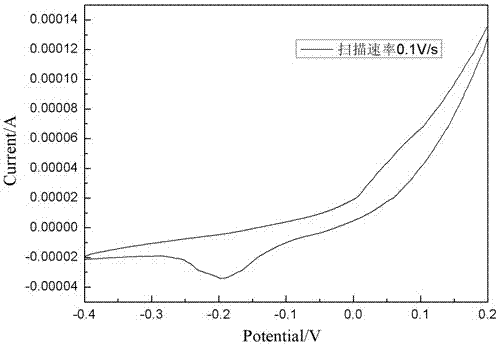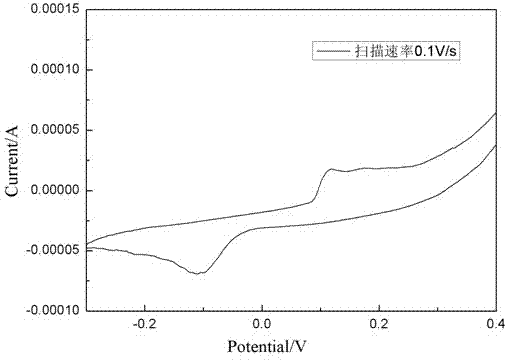Method for preparing amino functional multiporous silica-based composite material for ion detection
An amino-functionalized, porous silicon-based technology, applied in the analysis of materials, material analysis by electromagnetic means, and measurement devices, can solve the problems of complex pretreatment, high operating costs, and expensive costs, and achieve high sensitivity and selectivity. , Efficient surface modification, high surface activity effect
- Summary
- Abstract
- Description
- Claims
- Application Information
AI Technical Summary
Problems solved by technology
Method used
Image
Examples
Embodiment 1
[0028] A. The P-type silicon wafers with a resistivity of 0.01~0.09Ω·cm were ultrasonically cleaned with absolute ethanol and deionized water for 5 minutes, and then immersed in hydrofluoric acid with a mass concentration of 10% for 10 minutes, and then placed the silicon wafers Put the volume ratio of deionized water: absolute ethanol: 50% hydrofluoric acid with a mass concentration of 1:1:1 into the etching solution, and use the double cell or single cell electrochemical etching method to use the silicon wafer as the anode. Platinum sheet is used as the negative electrode, applying 40mA / cm 2 The corrosion current is 30 minutes, that is, the silicon wafer is corroded to obtain porous silicon with a nanometer pore size;
[0029] B. The porous silicon obtained in step A was ultrasonically cleaned with absolute ethanol and deionized water for 10 minutes, and then the surface of the porous silicon was thermally oxidized at 100°C for 1 hour to introduce silicon hydroxyl bonds (Si-OH...
Embodiment 2
[0032] A. The P-type silicon wafers with a resistivity of 0.01~0.09Ω·cm were ultrasonically cleaned with absolute ethanol and deionized water for 20 minutes, and then soaked in hydrofluoric acid with a mass concentration of 5% for 5 minutes, and then the silicon wafers were placed Put the volume ratio of deionized water: absolute ethanol: mass concentration of 5% hydrofluoric acid = 0.5: 5: 0.5 in the etching solution, using double cell or single cell electrochemical etching method to use silicon wafer as anode, Platinum sheet is used as the negative electrode, applying 5mA / cm 2 The corrosion current is 80 minutes, that is, the silicon wafer is corroded to obtain porous silicon with a nanometer pore size;
[0033] B. The porous silicon obtained in step A was ultrasonically cleaned with absolute ethanol and deionized water for 1 minute in turn, and then thermally oxidized at 50°C for 3 hours to introduce silicon hydroxyl bonds (Si-OH) on the surface, and then press The solid-to-...
Embodiment 3
[0036] A. The N-type silicon wafers with a resistivity of 0.01Ω·cm were ultrasonically cleaned with absolute ethanol and deionized water for 1 minute, then immersed in hydrofluoric acid with a mass concentration of 40% for 1 minute, and then put the silicon wafers into the volume The ratio is deionized water: absolute ethanol: 60% hydrofluoric acid with a mass concentration of 2:10:5 in an etching solution, using double cell or single cell electrochemical etching method to use silicon wafer as anode, platinum wafer As the negative electrode, apply 100mA / cm 2 The corrosion current is 5 minutes, that is, the silicon wafer is corroded to obtain porous silicon with a pore size of the order of microns;
[0037] B. The porous silicon obtained in step A was ultrasonically cleaned with absolute ethanol and deionized water for 30 minutes, and then the surface of the porous silicon was thermally oxidized at 200°C for 0.5h to introduce silicon hydroxyl bonds (Si-OH) on the surface, and the...
PUM
| Property | Measurement | Unit |
|---|---|---|
| Resistivity | aaaaa | aaaaa |
| Resistivity | aaaaa | aaaaa |
| Resistivity | aaaaa | aaaaa |
Abstract
Description
Claims
Application Information
 Login to View More
Login to View More - R&D
- Intellectual Property
- Life Sciences
- Materials
- Tech Scout
- Unparalleled Data Quality
- Higher Quality Content
- 60% Fewer Hallucinations
Browse by: Latest US Patents, China's latest patents, Technical Efficacy Thesaurus, Application Domain, Technology Topic, Popular Technical Reports.
© 2025 PatSnap. All rights reserved.Legal|Privacy policy|Modern Slavery Act Transparency Statement|Sitemap|About US| Contact US: help@patsnap.com


